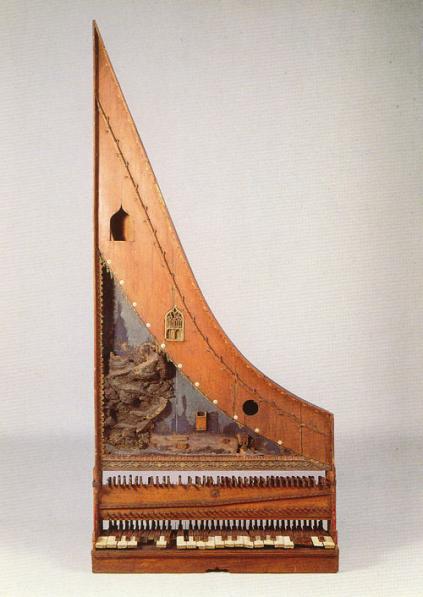Claviciterium

Claviciterium, South German (Ulm?), c. 1480; in London, Royal College of Music Museum of Instruments
This is one of the oldest surviving keyed string instruments of its kind. Despite the extensive damage and loss of individual parts over the centuries, some important details can still be identified, such as the bright guide rack for the jacks directly below the elaborate decoration.
Music sample:
Excerpt from Ludwig Senfl: Homo quidam fecit cenam
played by René Clemencic
Instrument: Philippe Humeau, reproduction of the claviciterium in London RCM
Music sample:
An excerpt from Guillaume de Machaut's "De toutes flours" from the Codex Faenza,
Italy, 15th century,
played by Marcel Pérès.
Instrument: Emile Jobin, a copy of an Italian claviciterium (with gut strings).
The claviciterium was quite popular, yet still rare. Players appreciated the instrument for its optimal sound projection, as the strings were at head height, an advantage that later contributed to the temporary popularity of upright pianos. However, the playing mechanism of all upright instruments, be it harpsichord or pianoforte, was exceedingly complicated, as the jacks or hammers did not automatically (i.e. by gravity) return to their original position after releasing the key.
This problem had to be solved by using either individual return springs or counterweights on the keys (with jacks additionally connected to the key ends by a joint). Regardless of the construction used, the action mechanism of a claviciterium was always considerably more complex and, above all, more cumbersome than that of a horizontal instrument. Therefore, claviciteria were often admired (no treatise of the time omits them) but did not play a very significant role in musical practice.
However, their curiosity value led to a comparatively large number of claviciteria being preserved over the centuries. It is not entirely coincidental that the claviciterium depicted here is also one of the oldest surviving harpsichords altogether. Today, it is believed that it was made in the second half of the 15th century in one of the Upper German imperial cities (probably Ulm) or possibly in Italy.



